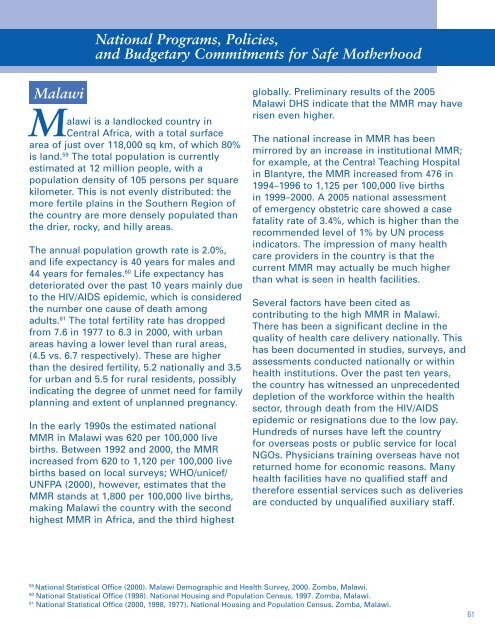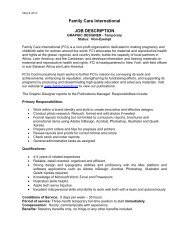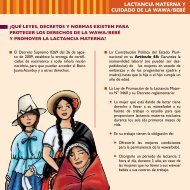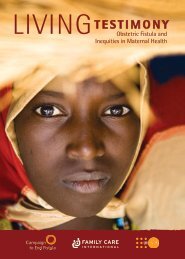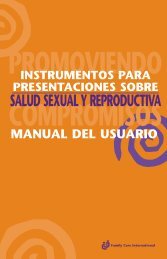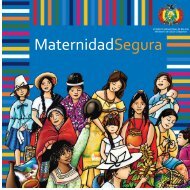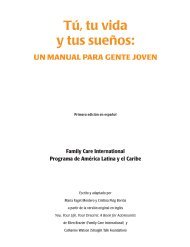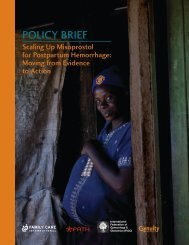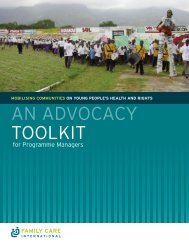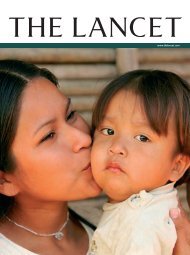Safe Motherhood: A Review - Family Care International
Safe Motherhood: A Review - Family Care International
Safe Motherhood: A Review - Family Care International
Create successful ePaper yourself
Turn your PDF publications into a flip-book with our unique Google optimized e-Paper software.
Malawi<br />
National Programs, Policies,<br />
and Budgetary Commitments for <strong>Safe</strong> <strong>Motherhood</strong><br />
Malawi is a landlocked country in<br />
Central Africa, with a total surface<br />
area of just over 118,000 sq km, of which 80%<br />
is land. 59 The total population is currently<br />
estimated at 12 million people, with a<br />
population density of 105 persons per square<br />
kilometer. This is not evenly distributed: the<br />
more fertile plains in the Southern Region of<br />
the country are more densely populated than<br />
the drier, rocky, and hilly areas.<br />
The annual population growth rate is 2.0%,<br />
and life expectancy is 40 years for males and<br />
44 years for females. 60 Life expectancy has<br />
deteriorated over the past 10 years mainly due<br />
to the HIV/AIDS epidemic, which is considered<br />
the number one cause of death among<br />
adults. 61 The total fertility rate has dropped<br />
from 7.6 in 1977 to 6.3 in 2000, with urban<br />
areas having a lower level than rural areas,<br />
(4.5 vs. 6.7 respectively). These are higher<br />
than the desired fertility, 5.2 nationally and 3.5<br />
for urban and 5.5 for rural residents, possibly<br />
indicating the degree of unmet need for family<br />
planning and extent of unplanned pregnancy.<br />
In the early 1990s the estimated national<br />
MMR in Malawi was 620 per 100,000 live<br />
births. Between 1992 and 2000, the MMR<br />
increased from 620 to 1,120 per 100,000 live<br />
births based on local surveys; WHO/unicef/<br />
UNFPA (2000), however, estimates that the<br />
MMR stands at 1,800 per 100,000 live births,<br />
making Malawi the country with the second<br />
highest MMR in Africa, and the third highest<br />
globally. Preliminary results of the 2005<br />
Malawi DHS indicate that the MMR may have<br />
risen even higher.<br />
The national increase in MMR has been<br />
mirrored by an increase in institutional MMR;<br />
for example, at the Central Teaching Hospital<br />
in Blantyre, the MMR increased from 476 in<br />
1994–1996 to 1,125 per 100,000 live births<br />
in 1999–2000. A 2005 national assessment<br />
of emergency obstetric care showed a case<br />
fatality rate of 3.4%, which is higher than the<br />
recommended level of 1% by UN process<br />
indicators. The impression of many health<br />
care providers in the country is that the<br />
current MMR may actually be much higher<br />
than what is seen in health facilities.<br />
Several factors have been cited as<br />
contributing to the high MMR in Malawi.<br />
There has been a significant decline in the<br />
quality of health care delivery nationally. This<br />
has been documented in studies, surveys, and<br />
assessments conducted nationally or within<br />
health institutions. Over the past ten years,<br />
the country has witnessed an unprecedented<br />
depletion of the workforce within the health<br />
sector, through death from the HIV/AIDS<br />
epidemic or resignations due to the low pay.<br />
Hundreds of nurses have left the country<br />
for overseas posts or public service for local<br />
NGOs. Physicians training overseas have not<br />
returned home for economic reasons. Many<br />
health facilities have no qualified staff and<br />
therefore essential services such as deliveries<br />
are conducted by unqualified auxiliary staff.<br />
59 National Statistical Office (2000). Malawi Demographic and Health Survey, 2000. Zomba, Malawi.<br />
60 National Statistical Office (1998). National Housing and Population Census, 1997. Zomba, Malawi.<br />
61 National Statistical Office (2000, 1998, 1977). National Housing and Population Census. Zomba, Malawi.<br />
61


